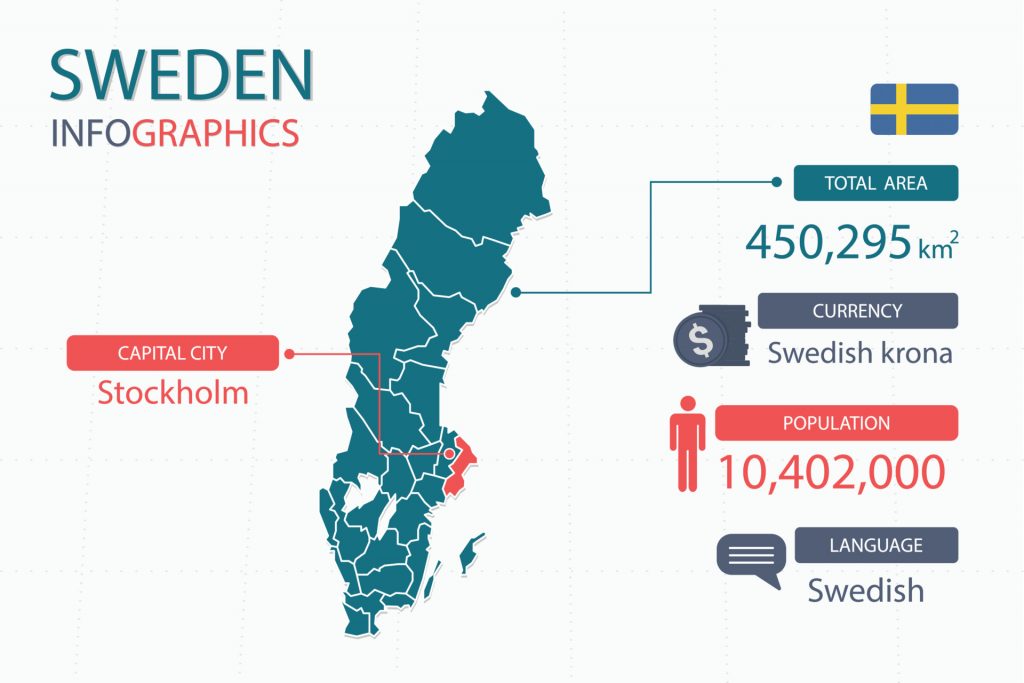The origins of the Swedish Language
Swedish language is a language spoken in Sweden as an official language, and parts of Finland, where it has the same level of legal status as Finnish. It is spoken by nearly 10 million people, and it is an official language of the European Union as well as a working language of the Nordic Council.
The Swedish grammatical system classifies nouns into two genders. The word order is similar to that of German, where the verb is always in the second position while other elements are moved around more freely. Nouns also have a definite form and an indefinite form, in addition to definite articles, describing different degrees of definiteness. As an example, flaska means ‘bottle’. However, flaskan means ‘the bottle.’ Adding additional articles before it would make it more specific, changing the meaning to ‘that bottle’ or ‘this bottle’.
Swedish is also very similar to German in the sense that words can be combined to produce compound words, which at times, can be become quite long.
As a North Germanic language, the base of Swedish vocabulary is mainly Germanic. However, throughout its history, it has borrowed extensively from French, taking words that were originally came from Latin or Greek, especially for religious vocabulary and scientific terminology. However, there have been some other borrowings from Scandaromani and Romani, as well as more recent additions from English due to the globalization of the English language.
Swedish uses the Latin Alphabet, like other Germanic languages. It contains the standard 26 letters as well as three additional ones that express Swedish sounds. These include Å/å, Ä/ä, and Ö/ö. It is written from left-to-right. Interestingly, the colon (:) is also used for some abbreviations as well. For example to express its currency (kronor) the colon is used as e.g. 100 :- to express 100 kronor.

The history of the Swedish language starts with it roots in Old Norse during the 8th century in Scandinavia. At this time, Old Norse used the Runic alphabet, before a Latin-based script was fully adopted. During this period, Old Norse was more of a group of dialects in the Scandinavian region, which included Denmark, Sweden, Norway, and Iceland.
The history of Swedish is classified by scholars into three periods, Old Swedish, Modern Swedish, and Now-Swedish.
In 1200, Swedish dialects and Denmark diverged from each other, which was the start of Old Swedish. This was the medieval Swedish language, and is recognized by linguists in the Vastgota Law, Swedish law codes written in Latin script in 1225. During this time, heavy influences from the Christian church entered the language, with many Greek and Latin loan words being introduced.
Modern Swedish occurred when printing press technologies emerged, and is exemplified by the printing of the Bible, which had been translated into Swedish. During the 17th century, spelling became more consistent and the first Swedish grammars were written and published.
The period beginning in the 19th century until now is called Now-Swedish. Here, the written form and the spoken form have developed in a way where they closely resemble each other. There has also been an emergence of Book Swedish, due to the language that is promoted in the public schooling system, where the spelling has influenced the pronunciation of oral Swedish. In addition, there was a you reform in the 1960s. In Swedish, there were two ways to say “you”, similar to many Romance languages such as French and Spanish, where there is a familiar version and a more formal version, but more based on class. With the you reform, Swedish-speaking individuals only used the familiar form, even though older individuals may still differentiate when speaking.
Nowadays, Swedish being spoken in Sweden and Finland, there is Swedish from Sweden and also Finland Swedish. As Finland was a part of Sweden for about six centuries, it was the most prominent language in that region for both government and education, and a variety of Swedish that exist in Finland developed. However, since Finnish independence in 1917, the number of Swedish speakers have been steadily decreasing. In addition, there are also urban varieties of Sweden that have emerged in recent times, taking on characteristics of foreign languages that are used by Swedish immigrant communities. This group of varieties is commonly called Rinkeby Swedish by linguists.
Swedish is now the North Germanic language that boasts the largest number of speakers. It is mostly mutually intelligible with other languages in the region, including Norwegian and Danish, depending on the dialect employed. It is regulated by the Swedish Language Council, the Swedish Academy, and the Research Institute for the Languages of Finland. Many cultural institutes promote the use of Swedish, such as the Swedish Institute. It is a requirement in schools in Finland for those who do not already speak it. Internationally, Swedish can be seen on the name tags of furniture items, household goods, and cafeteria food selections in IKEA.
VEQTA can provide you with a perfect Swedish translator for your Swedish translation, English to Swedish translation and Swedish to english translation for the your targeted locale. Our translations to Swedish are created with your target audience in mind to meet your expectations.
If you need to translate Swedish – Get in touch today!
A dedicated team of Swedish translators who combines Experience, Specialized Subject Matter Expertise with Translation Practices to deliver quality second to none.
Swedish Subject Expertise
Swedish Translators
Swedish Editors
Swedish Copywriters
Swedish Reviewers
Swedish Voice dubbing
Swedish Subtitling
Swedish Transcription


